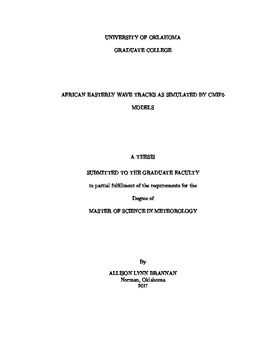| dc.contributor.advisor | Martin, Elinor | |
| dc.contributor.author | Brannan, Allison | |
| dc.date.accessioned | 2017-07-25T15:07:20Z | |
| dc.date.available | 2017-07-25T15:07:20Z | |
| dc.date.issued | 2017-08 | |
| dc.identifier.uri | https://hdl.handle.net/11244/51838 | |
| dc.description.abstract | African Easterly Waves (AEWs) impact Sahel rainfall and serve as trigger disturbances for tropical cyclones (TCs) in the North Atlantic Ocean. So far, there has been very little investigation into future changes in intensity and location of AEWs and how these changes would impact the TC activity of the Atlantic Basin and rainfall across the Sahel. Gaining a more detailed understanding of AEW behavior within global climate models will reduce the uncertainty surrounding these TC precursors, potentially yielding higher confidence in future Sahel rainfall and TC trends.
This study uses a Hovmoller tracking technique to identify and track AEWs at 850 hPa. The magnitude, frequency, location, and speed of the AEWs is compared between reanalysis products (e.g. JRA-55, CFSR, ERA-Interim) and the coupled historical simulations from the fifth phase of the Coupled Model Intercomparison Project (CMIP5) to establish historical biases. Results show the resolution of the models is more important in reducing biases in the northern track AEWs compared to the southern. The tracking technique is then applied to future simulations (Representative Concentration Pathway 8.5) within the CMIP5 experiments. It is found that the CMIP5 models project an average increase of 1.5 AEWs per year in the northern track, including an increase in higher intensity waves. The signals from the southern track AEWs in the future simulations are more varied compared to the northern track models, consistently resulting in a disagreement regarding future changes. However, there is indication of a shift in seasonality of southern track AEWs towards the later summer months, which may impact the timing of the Atlantic TC season. Future work will include a 3D tracking technique in order to definitively determine the two distinct AEW tracks. This may provide a clearer distinction between the northern and southern regions which could result in more significant changes in future AEW characteristics within each region. | en_US |
| dc.language | en_US | en_US |
| dc.subject | Tropical Meteorology, African Easterly Waves | en_US |
| dc.title | African Easterly Wave Tracks as Simulated by CMIP5 Models | en_US |
| dc.contributor.committeeMember | Furtado, Jason | |
| dc.contributor.committeeMember | Wang, Xuguang | |
| dc.date.manuscript | 2017-06-28 | |
| dc.thesis.degree | Master of Science in Meteorology | en_US |
| ou.group | College of Atmospheric & Geographic Sciences::School of Meteorology | en_US |
